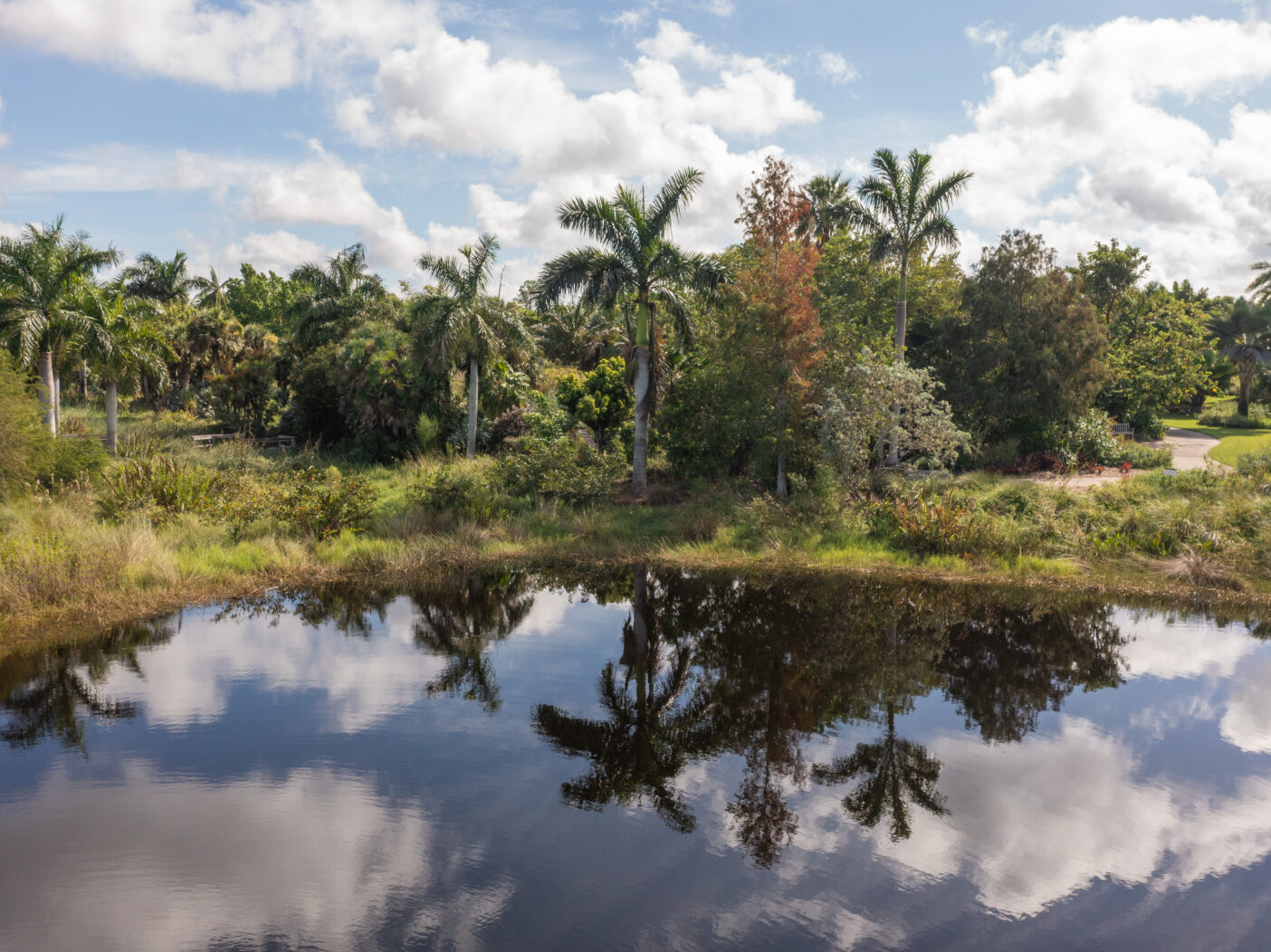
We’ve received nearly 80 inches of rainfall at the Garden in 2024—some 30 inches more than the 30-year average, according to our rain gauge, which is part of a National Oceanic and Atmospheric Administration monitoring program.
While the frequent watering certainly helps plants flourish, rain can negatively impact ponds and other waterbodies. That’s because rainwater picks up contaminants on land and carries them into storm drains, retention ponds, canals, and the like. But there are simple ways to cleanse runoff and tools that homeowners can use to improve the health of Southwest Florida’s water.
It starts with the power of plants.
How water gets tainted and algae takes over
Before we explain the role plants play, let’s look at two sources of water contamination—nitrogen and phosphorus—how they get into the system, and the problems they can cause.
We have a love-hate relationship with these nutrients. On the one hand, they boost food production and make landscapes lush. On the other, they amplify algae. When too much nitrogen and phosphorus enter waterbodies through fertilizers, farm waste, leaking septic tanks, and other sources, they can feed algae and cause devastating blooms.
In 2018, simultaneous occurrences of red tide and blue-green algae cost Southwest Florida some $184 million in lost tourism revenue and related costs, according to a University of Florida study. Globally, algal blooms are responsible for hundreds of “dead zones” that result from algae dying, decomposing, and consuming the oxygen in the water, killing or dislocating marine life. One persistent dead zone is found in the Gulf at the mouth of the Mississippi River. The National Oceanic and Atmospheric Administration projects it will be nearly 6,000 square miles this year, larger than Connecticut.
On a more direct level, algae can make people and pets sick, with everything from respiratory irritation to neurological impacts.
We won’t get into the policy and regulatory decisions that could curtail nitrogen and phosphorus, matters largely out of our hands. Instead, let’s look at two tools at homeowners’ disposals: neighborhood stormwater pond management and, to a lesser extent, bioswales.
The ponds are ubiquitous—Southwest Florida has more than 10,000 of them in neighborhoods alone. The principles behind bioswales are roughly the same; they are just less often found in residential developments. We recently installed a new one in our Preserve that we’re using for stormwater treatment and as a demonstration area.
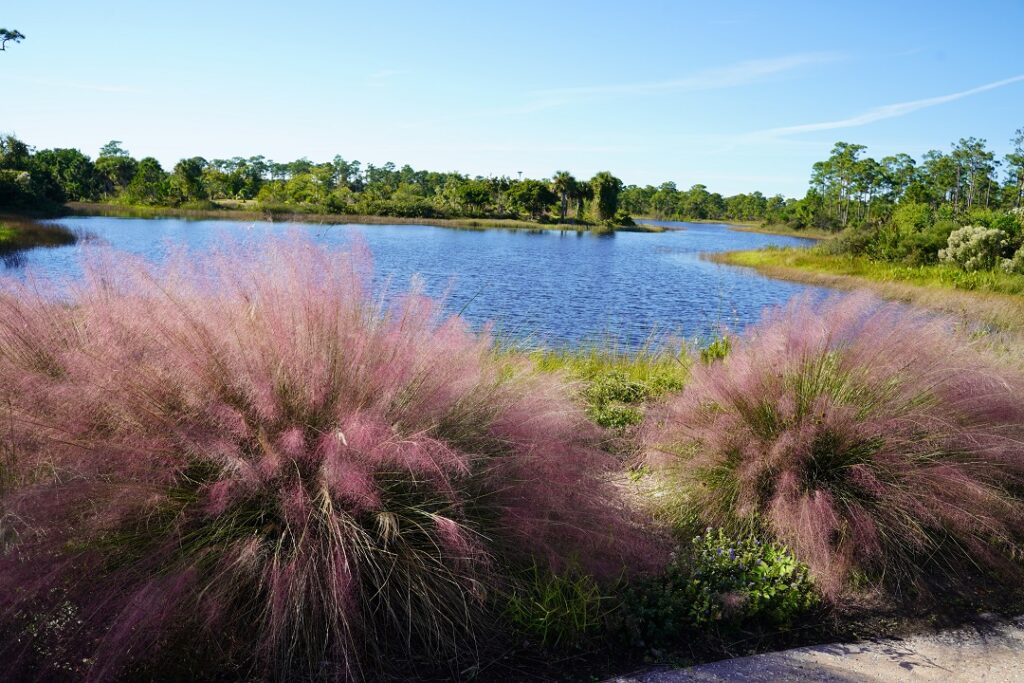
Plants: Water’s Protectors
A littoral zone is the transitional area between land and water.
Plants grown in a littoral zone offer lots of benefits:
- They act like filters, absorbing excess nitrogen, phosphorus, and other potentially harmful substances.
- They serve as a buffer, keeping things like grass clippings—another significant nitrogen and phosphorus source—out of the water.
- They limit erosion, an important function for waterfront homeowners who don’t want to see their backyards slowly disappear!
- They also provide habitat for everything from fish to wading birds to pollinators.
Too often, though, we see ponds managed in ways that hurt rather than help. When ponds are mowed straight to the water’s edge, for example, lawn clippings infiltrate the water and pollutant-filtering native grasses can’t establish. The following guidelines will help your neighborhood establish a healthy pond.
Pond management tips
- Talk to your neighborhood’s lake management company about installing appropriate native plants around lakes. Our experts developed a recommended plant list (see below) for littoral zones and swales.
- Make sure your community landscape firm and your pond management company communicate with each other. It’s important that landscapers understand what pond managers are trying to accomplish with littoral zone plantings.
- Leave a buffer, preferably 10 feet or more, around your pond where you plant the Garden’s recommended species, and prohibit mowing, fertilizer application, and pesticide/herbicide use.
- Plant for beauty as well as function. Our recommended plants include flowering varieties and those with foliage of wide-ranging textures and hues.
- Don’t fertilize your littoral plantings! Their whole purpose is to keep those algae-boosting nutrients out of the water.
- Clean up grass clippings after mowing to keep them out of the water.
- Avoid introducing grass carp, a fish that pond management companies use to control undesirable plants. Unfortunately, the carp can’t distinguish between a “good” and “bad” plant and will eat your littoral zone plantings.
- Pick up pet waste and (politely) insist your neighbors do so, too.
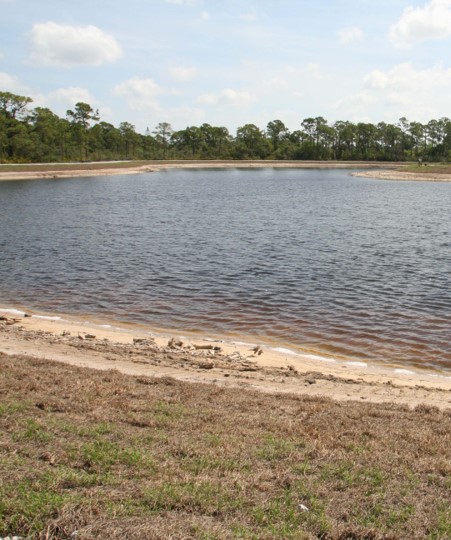
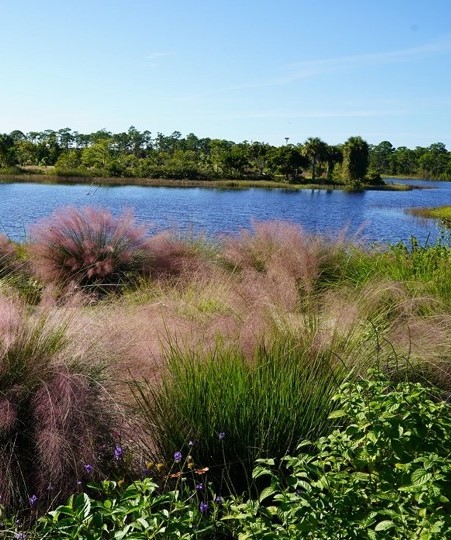
See plants in action
Naples Botanical Garden was designed around a stormwater management system that mimics how nature handles rain. It includes the Mary and Stephen Byron Smith River of Grass, which acts like a mini-Everglades; bioswales and a rain garden in our main parking lot; planted littoral zones around the lakes; and our newest feature, the 300-by-20-foot swale created in cooperation with Collier County. We partnered on that project after the county decided to expand a parking area along Hamilton Avenue, which would generate more runoff.
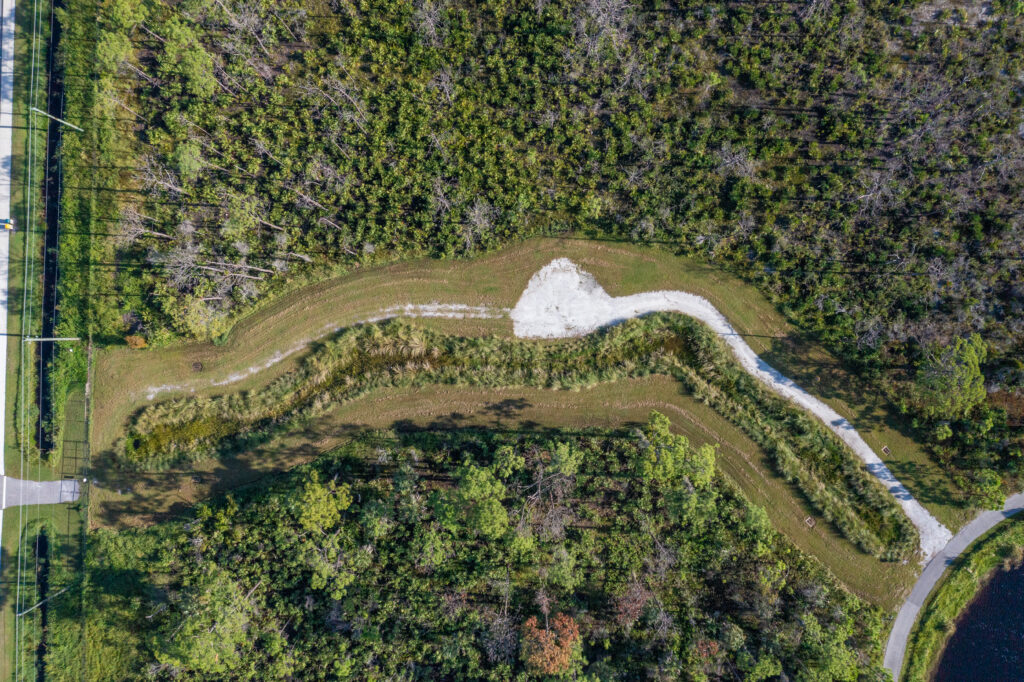
Our recommended plants
A littoral zone is divided into three areas with three plant types:
- Emergent: Here, you’ll find plants rooted in water. They range from partially submerged to completely flooded, depending on water levels.
- Transitional: These plants are found on lake banks and include those that root in shallow water, those that require dry conditions, and those that can manage both wet and dry periods. You’ll find many grass species in this area.
- Upland Buffer: This area is located between the littoral zone and landscaped areas, such as lawns and garden beds. The buffer should not be fertilized or mowed. A healthy upland buffer will help reduce fertilizer runoff and grass clippings from entering the water. It also will slow the flow of water to reduce erosion.
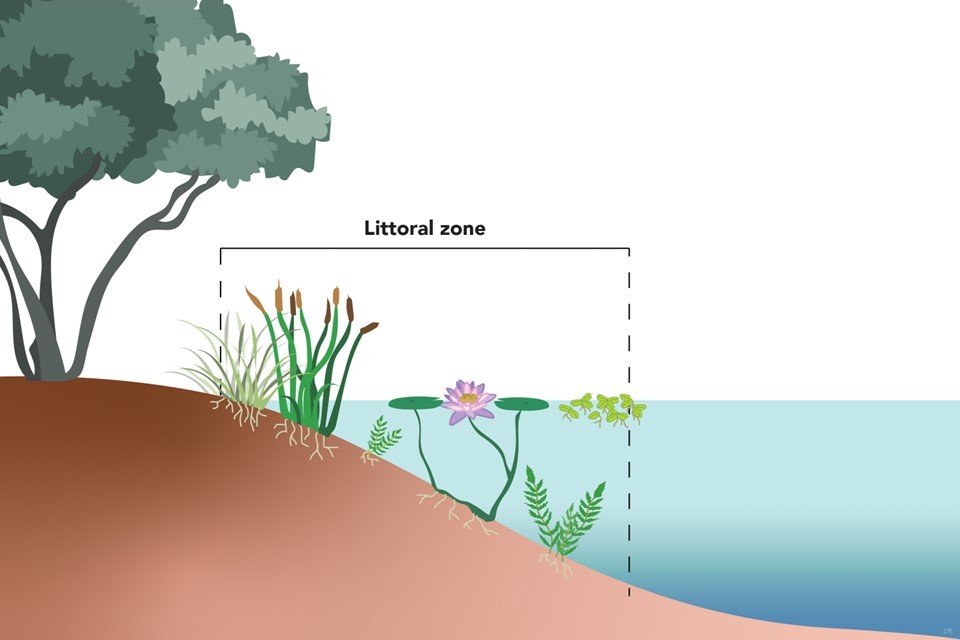
Emergent Plants
Gulfcoast Spikerush (Eleocharis interstincta) and Knotted Spikerush (Eleocharis cellulosa)
We recommend planting these spikerush species together in the emergent zone. Both grow in wide bands that top out at about 3 feet in height. They differ in their salt tolerance with knotted spikerush able to handle slightly more saline conditions. Having diverse plantings, like these two species together, means your littoral zone will be able to handle changing environmental conditions from season to season and year to year.
Transitional Plants
Duck Potato (Sagittaria latifolia) and Lance Leaf Arrowhead (Sagittaria lancifolia)
We recommend planting these two related species together as accents in the emergent zone. They favor organic soils, grow 2 – 3 feet tall, and spread rapidly. Both produce white flowers with yellow centers, adding a touch of beauty to the hardworking littoral zone.
Prairie Iris (Iris hexagona)
Much like the swamp lily (see next section), these are rarely seen until they bloom. Prairie iris grows about 3 feet tall and should be planted in masses and treated like accents, mixed in with emergent plants.
Upland Buffer/Transitional Plants
Sand Cordgrass (Spartina bakerii)
For a natural look, you can mix sand cordgrass, a native ornamental, in with other grasses. For a more cultivated appearance, you can clump them together. If you decide to do the latter, plant the clumps rather close together to cover gaps and crowd out weeds. This grass grows about 3 feet tall and 4 – 5 feet wide. It prefers moist soils but also tolerates drought.
Marshhay Cordgrass (Spartina patens)
Marshhay cordgrass, another native ornamental grass, makes a beautiful green area around your pond, growing 2 – 3 feet tall and reaching up to 4 feet when in flower. It begins as a clumping grass but spreads by rhizomes. Marshhay cordgrass is great for transitional areas. It does well on the lower banks below sand cordgrass, Fakahatchee and dwarf Fakahatchee, but it can tolerate some drought conditions higher up on the bank.
Pink Muhly Grass (Muhlenbergia capillaris)
Muhly grass is a great choice for the upper transitional area. We recommend it as an accent plant, not as a mass planting. Muhly grass blooms in the fall, creating tufts of pink. When dormant, however, it can look a little messy. We suggest blending it in with other plants, which will mask its appearance until it blooms and steals the show.
Golden Leather Fern (Acrostichum aureum)
There are two native leather ferns: golden and Everglades. We recommend the golden variety. It is more attractive and more self-contained than the sprawling Everglades leather fern.
The golden leather fern grows about 4 – 5 feet tall and equally broad in the transitional area and does best in moist to wet soils. Its height and expansiveness may inhibit the viewshed, so choose your planting locations carefully. We recommend it as an accent plant to break up grasses and add visual interest.
Swamp Lily (Crinum americanum)
These flowers are almost like hidden surprises. They grow 2 – 3 feet tall; however, you aren’t likely to notice them until they flower, producing beautiful white blooms. Swamp lilies are best planted scattered throughout emergent areas. (When planted in masses, they can attract lubber grasshoppers, which devour the leaves). Like other accent plants, these waterlilies do best in organic soils.
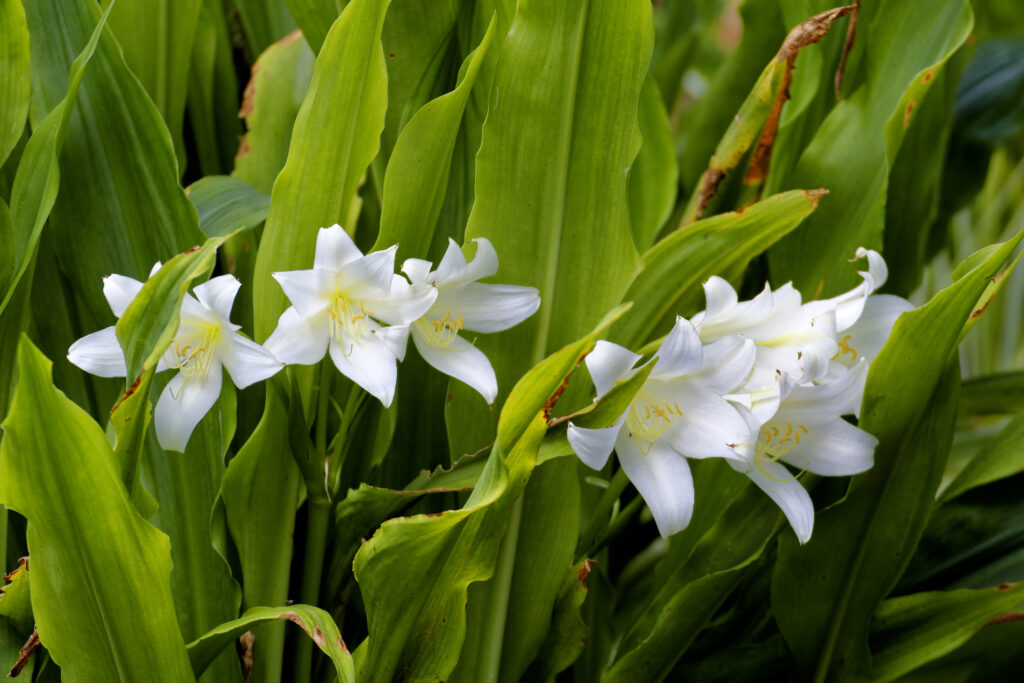
Upland Buffer Plants
Fakahatchee Grass (Tripsacum dactyloides)
Fakahatchee grass, a native ornamental clumping grass, grows quite large, typically 3 – 4 feet with flower spikes as high as 6 feet when in bloom. Plant this species in areas where it will not block viewsheds. Fakahatchee grass prefers moist soils on upland banks and buffers. Plant it in masses, but not too close together as the clumps can get quite large.
Dwarf Fakahatchee Grass (Tripsacum floridanum)
You might see this grass referred to as “half-a-hatchee” as it is much shorter than its namesake, growing in clumps 2 – 3 feet tall with sparse flower spikes of 4 feet. Due to its size, it should not block views. While dwarf Fakahatchee grass likes moist soils, it is also highly drought tolerant. It is a great plant for lake banks and buffers.
Trees
You don’t want to overdo it with trees for the sake of maintaining lake views, but a few strategically planted species can add a lot of visual interest. With the exception of bald cypress, which are appropriate for transitional areas, these trees fare best in the upland buffer zone.
Buttonwood (Conocarpus erectus)
Buttonwoods are sometimes mistaken for mangroves, but these diverse trees can exist inland, too. Buttonwoods handle drought and floods, but they also can be used as street trees. You can manage these species as a tree or maintain them as a shrub. They’re great hosts for other plants, too, including orchids, bromeliads, and similar epiphytes.
Bald Cypress (Taxodium distichum)
Bald cypress are the kings of Florida’s swamps, so you’ll want to plant them where it’s wet. These towering trees give a vertical lift to horizontal viewsheds. True to their name, these trees shed their leaves in winter, but they have an attractive architecture even when “bald.”
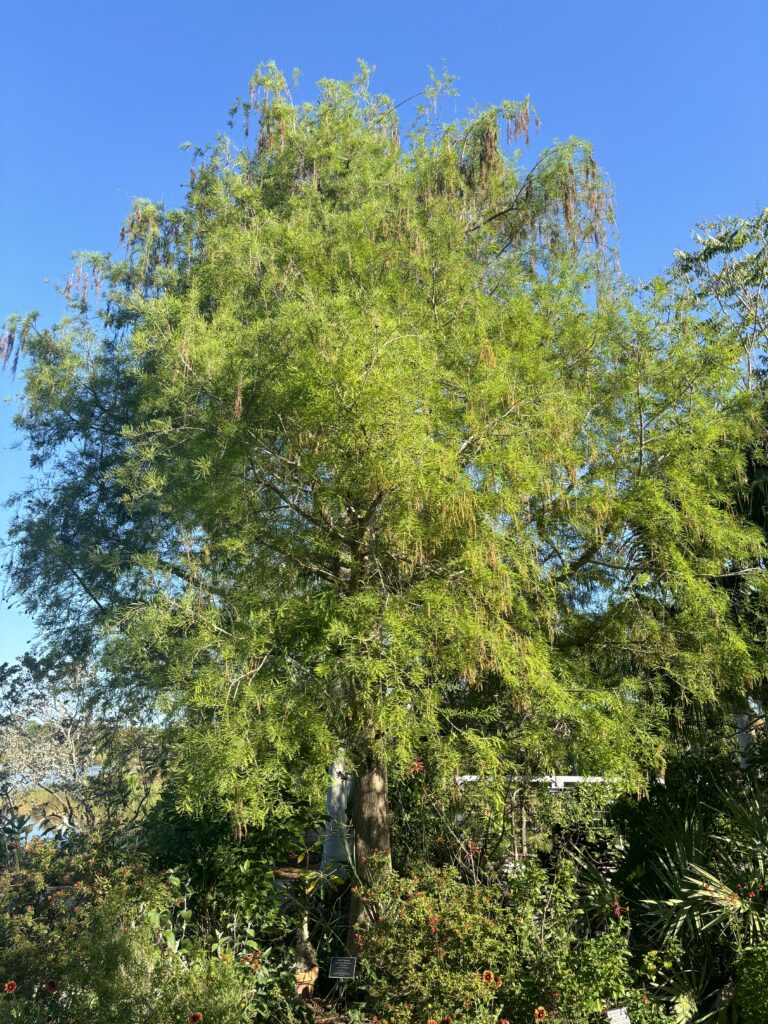
Dahoon Holly (Ilex cassine)
You might notice these trees and their bright berries along streetscapes; however, they’re really meant to be in swamps and moist forests. Be certain to ask your nursery or landscape firm to choose female trees, the producers of those vibrant fruits.
Sweetbay Magnolia (Magnolia virginiana)
Unlike its cousin, southern magnolia (Magnolia grandiflora), which is better suited to temperate regions, sweetbay magnolia thrives in our heat and humidity. These magnolias flower in spring and summer, produce silvery foliage, and feed wildlife through its seeds.
Red Maple (Acer rubrum)
These colorful trees provide lovely lakefront accents, with foliage ranging in hue from reds and pinks to greens and dark purples. They look especially nice when planted at the far end of an expansive viewshed or when planted close enough to the water’s edge that their foliage reflects on the surface. Note: These are shorter-lived trees and will need to be replaced after 15 – 20 years.
PLANT WITH CAUTION
The following plants are often used in littoral zone plantings, but we find them to be problematic.
Black Needlerush (Juncus roemerianus)
We advise against this plant unless you want the botanical equivalent of a needlestick. Its needle-like leaves are sharp enough to warrant the use of heavy gloves and protective eyewear when handling the plant.
Pickerelweed (Pontederia cordata)
Although pickerelweed is frequently included on plant lists, we advise against its use, as the species can be difficult to establish and rarely thrives in stormwater ponds. Moreover, it is unattractive during its dormant period.
Alligator Flag (Thalia geniculata)
Alligator flag goes dormant in the winter—prime time in Southwest Florida—and for that reason, we discourage its use.
Yellow Canna (Canna flaccida)
Although lovely when in bloom, yellow canna is quite unattractive during its dormant period. We favor other flowering plants, such as the swamp lily and Louisiana iris.
Giant Bulrushes (Schoenoplectus spp.)
We discourage the use of this plant. Bulrushes grow 7-9 feet tall, take over ponds, and obstruct viewsheds.

About the Author
Jennifer Reed is the Garden’s Editorial Director and a longtime Southwest Florida journalist.

